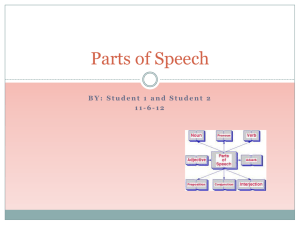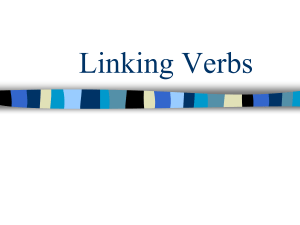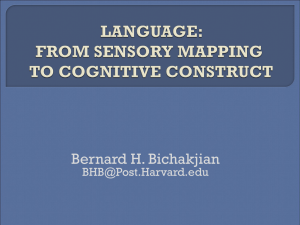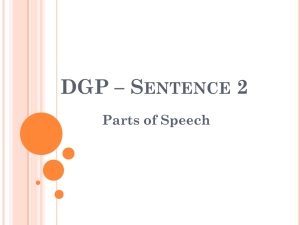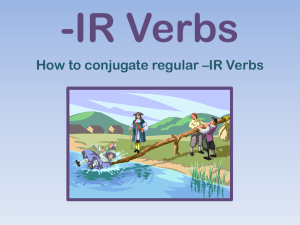Word Classes: An Introduction to English Grammar
advertisement
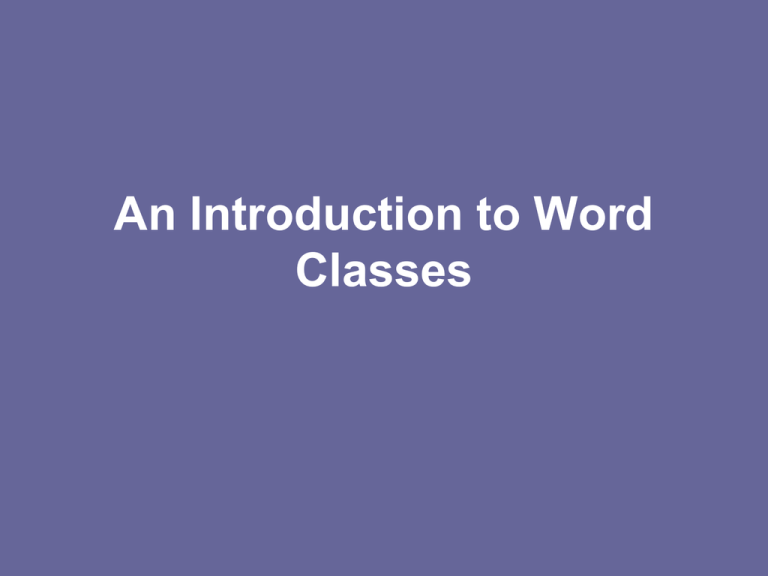
An Introduction to Word Classes Words are fundamental units in every sentence • my brother drives a big car • instinctively - brother and car are the same type of word • and also that brother and drives are different types of words. brother and car belong to the same word class brother and drives are different types, they belong to different word classes • We recognise seven MAJOR word classes: Verb Noun Determiner Adjective Adverb Preposition Conjunction be, drive, grow, sing, think brother, car, David, house, London a, an, my, some, the big, foolish, happy, talented, tidy happily, recently, soon, then, there at, in, of, over, with and, because, but, if, or Additional categories • articles < determiners • numerals • Types of verbs? • Types of conjunctions? The term parts of speech refers to an approach to classification of words • Words are analyzed on the basis of their formation • and their use in sentences (ex. noun?) • what are the forms like? • how are they used in sentences? We use a combination of three criteria for determining the word class of a word: 1. The meaning of the word 2. The form or ‘shape' of the word 3. The position or ‘environment' of the word in a sentence 1. Meaning brother London David people house car places things It can also be applied to verbs action cook, drive, eat, run, shout, walk This approach has certain merits • It allows us to determine word classes by replacing words in a sentence with words of "similar" meaning. My son cooks dinner every Sunday My son prepares dinner every Sunday My son eats dinner every Sunday My son misses dinner every Sunday However, this approach also has some serious limitations • The definition of a noun as a word denoting a person, place, or thing, excludes abstract nouns • Similarly, to say that verbs are "action" words excludes a verb like be, as in I want to be happy. 2. The form or ‘shape’ of a word • Some words can be assigned to a word class on the basis of their form or ‘shape’. • -tion ending (ex.) • -able or –ible (ex.) • Many words also take what are called INFLECTIONS = regular changes in their form under certain conditions. 3. The position or ‘environment’ of a word in a sentence • This criterion refers to where words typically occur in a sentence, and the kinds of words which typically occur near to them. [1] I cook dinner every Sunday [2] The cook is on holiday Cook can be a verb or a noun -- it all depends on how the word is used. • She looks very pale She's very proud of her looks • He drives a fast car He drives very fast on the motorway • Turn on the light I'm trying to light the fire I usually have a light lunch Of the three criteria for word classes that we have discussed here, the Grammar will emphasize the second and third - the form of words, and how they are positioned or how they function in sentences. Open and Closed Word Classes • Words are divided into grammatical classes, which are discriminated on the basis of three criteria: • semantic, • formal and • functional. • The semantic criterion deals with the most generalized meaning characterizing all the words in a class. • The formal criterion shows the specific word-building patterns and the grammatical forms of the words in a given grammatical class. • The functional criterion relates to the syntactic positions of words belonging to a particular class. On the basis of these criteria, words are divided into • lexical classes • functional series of words • To the lexical classes belong the noun, the verb, the adjective, the adverb and the numeral. • To the functional series of words belong the article, the preposition, the particle, the pronoun and the conjunction. Lexical classes • words of full nominative value with selfdependent syntactic functions • they are morphologically changeable units of language • these classes are OPEN The class of nouns • It is potentially infinite. • Example: Internet, website, CD-ROM, email, newsgroup, modem, multimedia New verbs have also been introduced: download, upload, reboot, right-click, doubleclick • The adjective and adverb classes can also be expanded by the addition of new words, though less prolifically. Functional words • They are of incomplete nominative value and non-self-dependent functions in the structure of the phrase or the sentence. • They constitute CLOSED systems. • They are made up of finite sets of words which are never expanded. Word Classes Based on Meaning • For example, generic vs. specific stative vs. dynamic assertive vs. nonassertive Generic & Specific • Generic vs. Specific is a way of explaining the meanings of nouns. • A noun has "generic" meaning when it refers to things, people, ideas, etc., generally as types rather than as specific individuals. • A computer is a machine. • The computer has changed modern life. • Computers are found just about everywhere. • Computation of grades is a process that computers handle efficiently. • Music can be played on computers. Generic Examples • I got a new computer for Christmas. • I installed the new computer early in the morning of December 24. • I now own 3 computers. • Without Microsoft Excel on my computer, I would find the process of doing my grades really frustrating. • I play the music of Beethoven on my computers. Specific Examples The distinction between generic and specific meaning is a terrifically important concept • selection of the articles a/an and the and the decision not to use an article at all • a/an, the, and 0 articles are used for both generic meanings and for specific meaning In the above examples • The generic set is about computers in general--not about any particular computer owned by any particular person. • The specific set is about me and my computers in my home. If we approach teaching articles based on how they are used with different types of nouns, we would say something like: a/an with singular nouns the with singular or plural or noncount nouns zero-article with plural or noncount nouns Stative vs. Dynamic • a way of classifying different types of verbs--or at least different meanings that verbs can have • Stative refers to "state of being" rather than "action." She is a teacher. He is a sociologist. (states of being rather than of activities) Dynamic refers to "actions" and "activity" in verb meanings: • He walks to class. • They eat lunch in the cafeteria. • The contrast is often used in ESL/EFL to help students understand why they can or cannot use a progressive verb form. That is, progressive verbs refer to actions rather than states of being. That's why this sentence is wrong: *They are knowing English very well. • The verb know generally is used for a "state of being" rather than an action, and so it can't be used in the progressive form (most of the time). In ESL/EFL materials we have lists of verbs divided into groups of Stative Verbs and Dynamic Verbs. • Actually: some verbs are just about always used for stative meanings; other verbs are just about always used for dynamic meanings; but...verbs can be switched from one class to the other for special purposes. For example, verbs like taste or smell can be either actions or states of being: • He was tasting the soup for salt when he dropped the box of salt in the pan. • The soup tastes pretty salty now. Assertive vs. Nonassertive • a way of talking about the difference between positive sentences and related negative sentences and questions. • positive sentences "assert" something • negative sentences and questions do not Assertive Examples • They have been to France already. • They had some French bread for dinner. • They saw somebody running out of the restaurant. Nonassertive Examples • They haven't been to Egypt yet. • They haven't had any Egyptian bread yet. • Did they have any French wine? • Did they see anybody they recognized? • They didn't see anyone that they knew.





